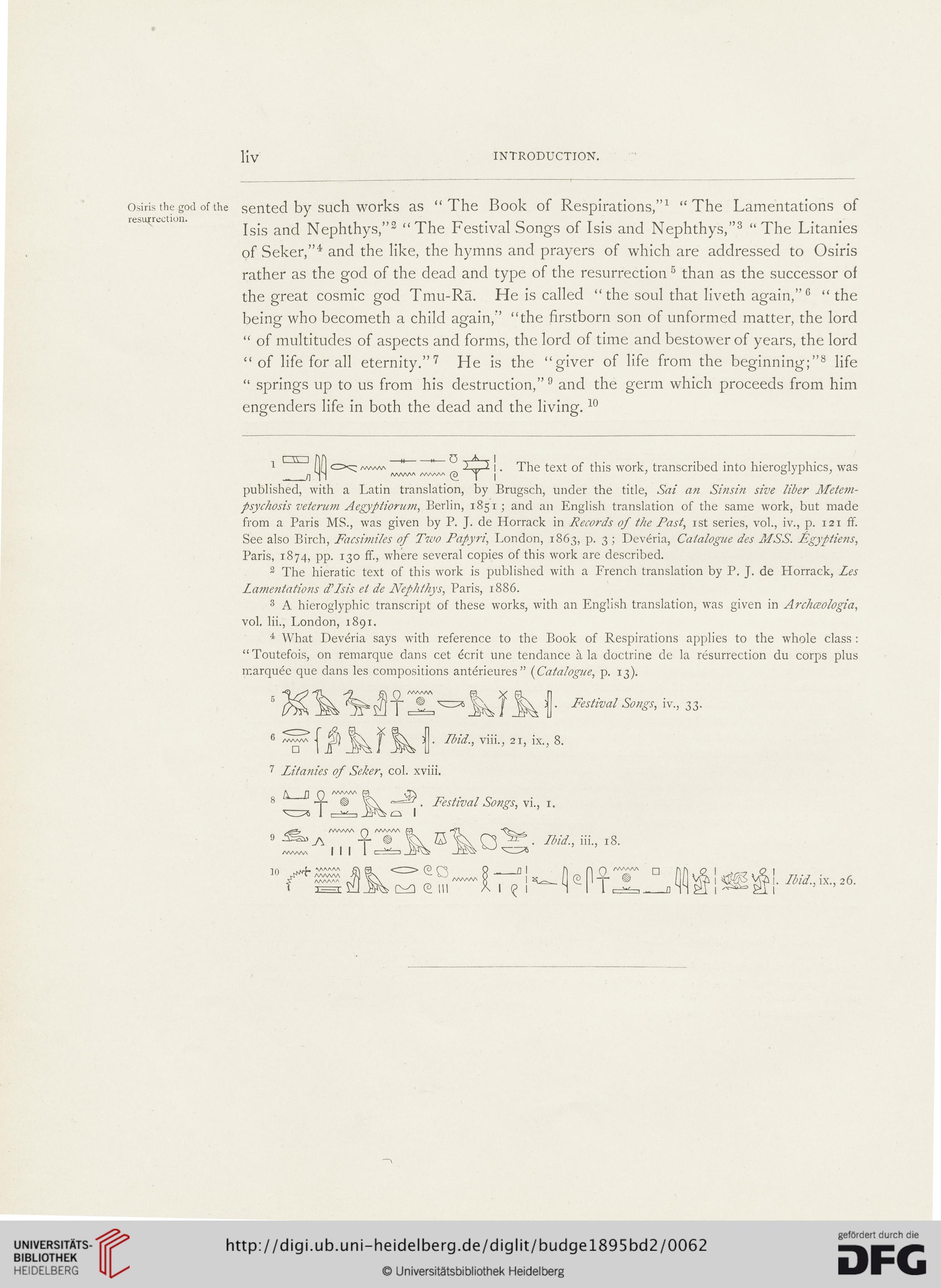liv
INTRODUCTION.
Osiris the god of the
resu^rection.
sented by such works as “ The Book of Respirations,”1 “ The Lamentations of
Isis and Nephthys,”2 “ The Festival Songs of Isis and Nephthys,”3 “ The Litanies
of Seker,”4 and the like, the hymns and prayers of which are addressed to Osiris
rather as the gocl of the dead and type of the resurrection5 than as the successor of
the great cosmic god Tmu-Ra. He is called “ the soul that liveth again,”6 “ the
being who becometh a child again,” “the firstborn son of unformed matter, the lord
“ of multitudes of aspects and forms, the lord of time and bestowerof years, the lord
“ of life for all eternity.”7 He is the “giver of life from the beginning;”8 life
“ springs up to us from his destruction,”9 and the germ which proceeds from him
engenders life in both the dead and the living.10
1 ' (j(j ^ |' The text ot" ttlis worL transcribed into hieroglyphics, was
published, with a Latin translation, by Brugsch, under the title, Sai an Sinsin sive liber Metem-
psychosis veieram Aegyptiorum, Berlin, 1851; and an English translation of the same work, but made
from a Paris MS., was given by P. J. de Horrack in Records of the Past, ist series, vol., iv., p. 121 ff.
See also Birch, Facsimiles of Two Papyri, London, 1863, p. 3 ; Deveria, Catalogue des MSS. fgyptiens,
Paris, 1874, pp. 130 ff., where several copies of this work are described.
2 The hieratic text of this work is published with a French translation by P. J. de Horrack, Les
Lamentations d’Lsis ei de Nephthys, Paris, 1886.
3 A hieroglyphic transcript of these works, with an English translation, was given in Archaologia,
vol. lii., London, 1891.
4 What Dev6ria says with reference to the Book of Respirations applies to the whole class :
“Toutefois, on remarque dans cet ^crit une tendance a la doctrine de la resurrection du corps plus
rr.arquee que dans les compositions anterieures” (Catalogue, p. 13).
Festival Songs, iv., 33.
/wwv\
□
Lbid., viii., 21, ix., 8.
7 Litanies of Seker, col. xviii.
INTRODUCTION.
Osiris the god of the
resu^rection.
sented by such works as “ The Book of Respirations,”1 “ The Lamentations of
Isis and Nephthys,”2 “ The Festival Songs of Isis and Nephthys,”3 “ The Litanies
of Seker,”4 and the like, the hymns and prayers of which are addressed to Osiris
rather as the gocl of the dead and type of the resurrection5 than as the successor of
the great cosmic god Tmu-Ra. He is called “ the soul that liveth again,”6 “ the
being who becometh a child again,” “the firstborn son of unformed matter, the lord
“ of multitudes of aspects and forms, the lord of time and bestowerof years, the lord
“ of life for all eternity.”7 He is the “giver of life from the beginning;”8 life
“ springs up to us from his destruction,”9 and the germ which proceeds from him
engenders life in both the dead and the living.10
1 ' (j(j ^ |' The text ot" ttlis worL transcribed into hieroglyphics, was
published, with a Latin translation, by Brugsch, under the title, Sai an Sinsin sive liber Metem-
psychosis veieram Aegyptiorum, Berlin, 1851; and an English translation of the same work, but made
from a Paris MS., was given by P. J. de Horrack in Records of the Past, ist series, vol., iv., p. 121 ff.
See also Birch, Facsimiles of Two Papyri, London, 1863, p. 3 ; Deveria, Catalogue des MSS. fgyptiens,
Paris, 1874, pp. 130 ff., where several copies of this work are described.
2 The hieratic text of this work is published with a French translation by P. J. de Horrack, Les
Lamentations d’Lsis ei de Nephthys, Paris, 1886.
3 A hieroglyphic transcript of these works, with an English translation, was given in Archaologia,
vol. lii., London, 1891.
4 What Dev6ria says with reference to the Book of Respirations applies to the whole class :
“Toutefois, on remarque dans cet ^crit une tendance a la doctrine de la resurrection du corps plus
rr.arquee que dans les compositions anterieures” (Catalogue, p. 13).
Festival Songs, iv., 33.
/wwv\
□
Lbid., viii., 21, ix., 8.
7 Litanies of Seker, col. xviii.





